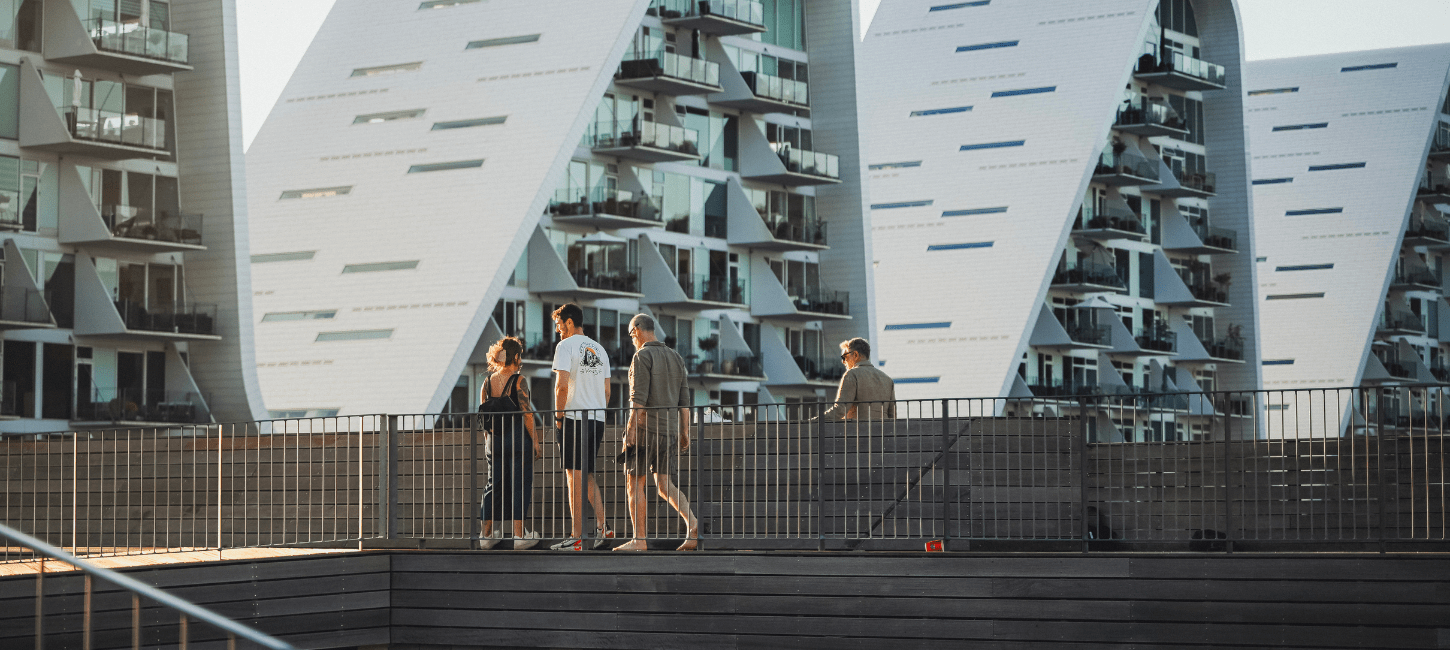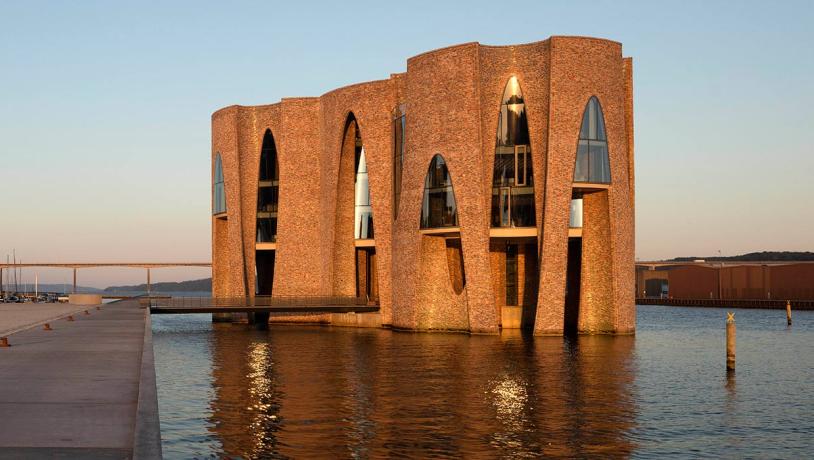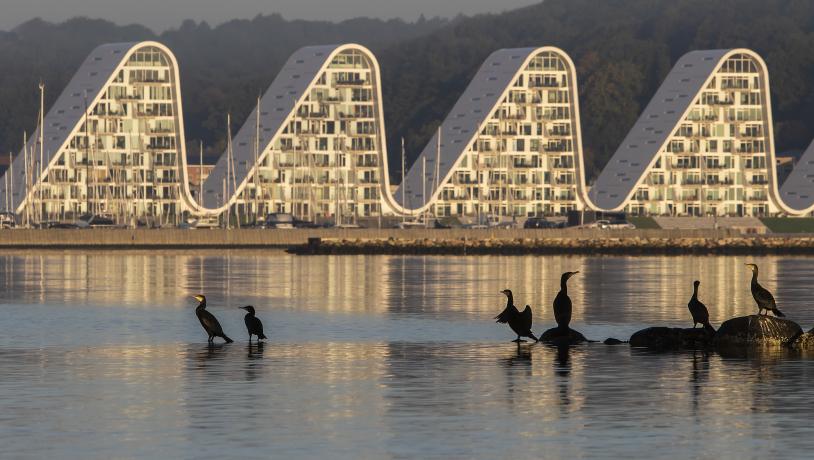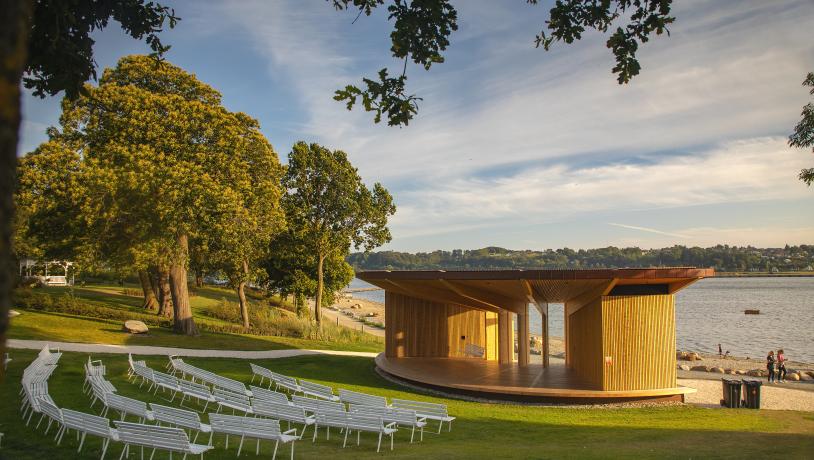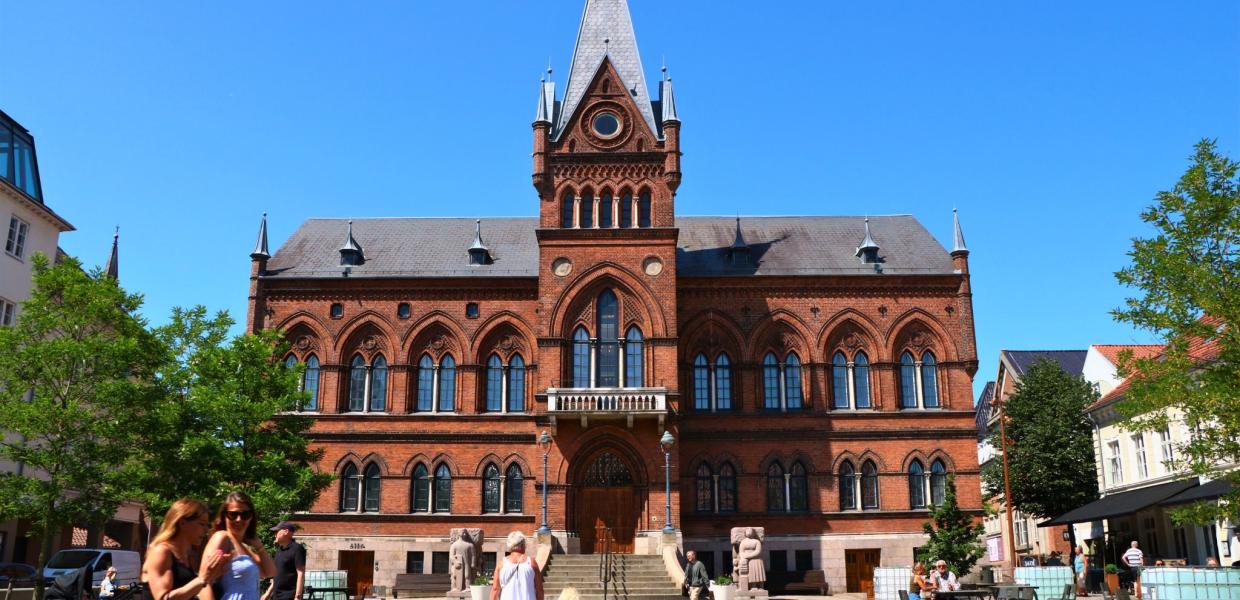City walk at Vejle harbour and inlet
VisitVejle welcomes you to a tour of the district by Vejle harbour and inlet. Explore the history of Vejle, and experience the newest part of the city. The tour is appox. 5,8 km.
Join us on a city walk through the district by Vejle's harbor and fjord.
The walking tour takes approx. 2 hours at a leisurely pace, including stops. Enjoy!
On this page you will find:
- Map with route for download as PDF
- An interactive map that you can open with Google Maps
- Description of the city walk and the many exciting stops along the way
The city walk is also available in printed format. You can find it free of charge at VisitVejle's tourist office at Banegårdspladsen 8 in Vejle.
Information for wheelchair users and people with walking difficulties
♿ This route is wheelchair accessible. However, please note, that in the area around Zleep Hotel (Note: The hotel is now called Four Points Flex by Sheraton Vejle) (26) and Fjordenhus (27) there is cobblestone pavement that is difficult to completely avoid. However, you can follow a small asphalt path from the bridge near Zleep Hotel to Fjordenhus. The asphalt path is located to the right of the small bridge and runs along the edge towards the water.
Download PDF with map and route for city walk
Start your city walk
1. Your route starts in front of VisitVejle (1) at Banegårdspladsen.
2. On the left is the DSB railway station. Walk through the tunnel at Vejle Banegård and out on the other side. You will now arrive at the cotton-spinning mills, Bomuldsspinderierne (23).
Vejle Bomuldsspinderi was the first cotton-spinning mill in Denmark and began production in 1892.
The cotton mill was powered by steam, and with industrialisation, cotton milling in the area got well underway. The cotton mills were the reason why Vejle was often called “Denmark’s Manchester” since around the turn of the century, Vejle was the most industrious provincial town in the nation. The production output was impressive, and in its heyday the cotton-spinning mills were the largest workplace in Vejle – also for women. Today, the old mill buildings have been converted into youth housing.
3. Turn left towards Havnegade and then right.
You are now at Havnegade (24).
Havnegade is one of Vejle’s oldest streets and has been an important trade route since the Middle Ages. After the construction of Vejle Harbour in 1827, Havneveien – currently called Havnegade – soon became an important thoroughfare connecting the new harbour at Holmen and Kirketorvet, the church square in central Vejle. The new harbour street was also considered attractive for home-owners and among the first residents were some of Vejle’s wealthiest citizens and town officials. For a number of years, this beautifully tree-lined paved street was also home to several fine hotels and cafés.
4. Follow Havnegade towards the roundabout at the end.
To your right, you can see the customs house, Det Kgl. Toldkammer (25).
The customs house from 1907 is a historic building with an impressive architecture and previously served as both a customs house and offices for a shipping company. When vessels docked at the old port in Vejle, they had to undergo inspection by having their papers and cargo checked for contrabands. Before the customs officials disembarked, it was customary at the time for the crew to offer them refreshments, which could include spirits.
Should they on occasion enjoy one too many of such refreshments, the officials could always take a nap on the bench in the guardhouse on the southern quay.
5. After a short walk by the harbour, follow the roundabout over to the left towards Windfeld-Hansens Gade. Follow the railway tracks.
6. When you reach the fuel station, turn right along Strandgade. You will now reach Fjordbyen.
Continue along the harbour until you reach Zleep Hotel (now Four Points Flex by Sheraton Vejle) (26) on your left. This modern hotel offers a rooftop sky bar. You can take the elevator up to the top floor where you can enjoy breathtaking views of Vejle and its river valley on one side, and the harbour and inlet waters to the other.
After enjoying the views from the sky bar, return to the harbour.
7. To the right, you find Fjordenhus (27), which with its unique architecture is designed by artist Olafur Eliasson in collaboration with Studio Olaf.
Inaugurated in 2018, the building serves as the HQ of Kirk Kapital A/S and is also the location of the Michelin-starred Restaurant Lyst. The building’s ground floor offers an impressive mix of art and architecture, where shades of green and blue in the specially-glazed masonry reflect the sea and the surrounding nature. The arched openings and windows are designed to frame magnificent views of the inlet and harbour, all while seawater flows naturally through some of the rooms. Fjordenhus is a contemporary gesamtkunstwerk, combining artworks, interiors and lighting designed especially for the building by Eliasson and his team.
Photo:Anders Sune Berg
8. Follow the path system past the apartments and cross the small bridge. Head directly towards Restaurant Remouladen and follow the street further along the harbourfront until you pass the marina, Lystbådehavnen (28).
The marina is part of Vejle’s waterfront development, which over the past few years has become an exciting new maritime district with canals and nautical charm, comprising a recreational area with a harborfront promenade, restaurant, floating bridges, kayak island, public areas and terraced observation points.
From the promenade, you can also see Bølgen (29).
This exclusive and exceptional residential complex consists of five tiled wave-like buildings located right by the waterfront.
Each “wave” has nine floors and totals 20 apartments enjoying magnificent views of the inlet and the town on either side respectively. The first two “waves” were completed in 2009, although further construction drew to a standstill during the financial crisis. The project was resumed in 2015, and by 2018 the last three waves had been completed. Bølgen was designed by the internationally recognised studio Henning Larsen Architects, which also masterminded the Opera House in Copenhagen, Moesgaard Museum by Aarhus and the Harpa conference centre and concert hall in Reykjavik. Bølgen has received several prestigious awards for its architecture and is one of Vejle’s most important contemporary landmarks.
Photo:Mads Fjeldsø Christensen
9. Walk past Bølgen to Tirsbæk Strandvej, turn right and follow the path along the inlet.
Make a stop along the way to enjoy the views across the inlet. Here you can also see the Vejle Bridge (30).
Before the bridge was constructed, traffic was diverted through the centre of Vejle, which resulted in increasingly dense congestion. In 1974, the Danish Parliament decided to build a new motorway from Kolding to Vejle, and after local lobbying from the politicians and citizens of Vejle, the construction of the Vejle Bridge commenced in 1975. The bridge was a much-needed improvement to the infrastructure of the town, but at the same time many residents feared that the bridge would become an eyesore in the inlet. The architects therefore decided to design the bridge to blend naturally and discreetly with the surrounding forested shores. The 1,712-metre-long bridge was inaugurated on 1 July 1980.
10. Continue along the inlet and turn right when you reach Skyttehushaven (31). In this waterfront parkland, you can follow the promenade.
Previously, the park belonged to Vejle Skyttelaug (Vejle Rifle Association), which in 1859 built a shooting range and the first buildings of the park. In 1868, the association added a dance pavilion, and in 1881 a music pavilion. In 1914, the wider public gained access to Skyttehushaven when it was purchased by Vejle Municipality. For over a century, the park was a favoured destination for public outings. Over the years, important annual gatherings, such Constitution Day and Midsummer’s Eve, were hosted in these beautiful surroundings. The octagonal clubhouse became a local venue for family reunions and cabaret performances in addition to serving as a dance pavilion.
In May 2019, Skyttehushaven was reopened after extensive transformation, which had been carried out with respect for the history and soul of the park.
Today, Skyttehushaven is a charming park with green areas and open-air seating. There is also an ice cream parlour, a playground, a beautiful old pavilion, a music pavilion and an aviary with birds.
Photo:Wamid Hassan
11. After a stroll through the park, return to Strandvejen.
Crossing the road, you will reach Dyrehaven, which is a beautiful forest with free-roaming fallow and sika deer.
12. Turn left and return along the inlet. At Bølgen, turn left and walk behind the building. When you reach the small roundabout, follow the path to the right through Klimaparken (32).
Klimaparken (i.e. The Climate Park) is designed to retain rainwater following flash floods. On a daily basis, the park and its courtyard is used as an urban recreational space by locals. During heavy downpours, the park is naturally transformed into rainwater reservoirs so residents in the valley avoid having their basements flooded. The basins are integrated into the park design, which is furthermore intended to inspire sustainable environmental awareness.
13. Cross the road at Ørstedsgade and follow the winding path until you reach Windfeld-Hansens Gade. Here you cross the road, walk through the carpark and down Strandgade.
14. When you reach Langelinie, turn left.
Here you will pass Den Gamle Kirkegård (33) on your right. This is Vejle’s oldest and smallest cemetery, which was consecrated in 1825 as a replacement for the original graveyard at Sct. Nicolai Church.
Originally, the cemetery was called “Assistentskirkegården” (Assistance Cemetery) and later simply “Kirkegården” (The Cemetery), until it was officially renamed "Gamle Kirkegård" (Old Cemetery) in 1871 when Østre Kirkegård was consecrated.
On the right, you will also see a magnificent building in neo-Gothic style designed by architect Ludvig Petersen. This is the prayer house Mamrelund (34), which experienced a dramatic consecration in 1885 when the floor of the hall suddenly began to sink under the feet of the congregation. For more than a century, the prayer house was the centre of the Vejle chapter of the evangelist movement Inner Mission, and in 1998 the building was sold and subsequently converted into youth housing in 2001.
15. Continue straight head along Langelinie until you reach Havnegade. Here you turn right and continue under the subway. Cross the street to reach VisitVejle where your tour began.
You have now returned to your starting point. Here you can visit VisitVejle for further information.
We hope you have enjoyed the trip and wish you a pleasant stay in our town.
